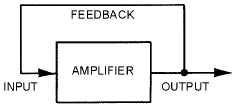2-2
Sinusoidal Oscillators
A sinusoidal oscillator produces a sine-wave output signal. Ideally, the output signal is of constant
amplitude with no variation in frequency. Actually, something less than this is usually obtained. The
degree to which the ideal is approached depends upon such factors as class of amplifier operation,
amplifier characteristics, frequency stability, and amplitude stability.
Sine-wave generators produce signals ranging from low audio frequencies to ultrahigh radio and
microwave frequencies. Many low-frequency generators use resistors and capacitors to form their
frequency-determining networks and are referred to as RC OSCILLATORS. They are widely used in the
audio-frequency range.
Another type of sine-wave generator uses inductors and capacitors for its frequency-determining
network. This type is known as the LC OSCILLATOR. LC oscillators, which use tank circuits, are
commonly used for the higher radio frequencies. They are not suitable for use as extremely low-frequency
oscillators because the inductors and capacitors would be large in size, heavy, and costly to manufacture.
A third type of sine-wave generator is the CRYSTAL-CONTROLLED OSCILLATOR. The crystal-
controlled oscillator provides excellent frequency stability and is used from the middle of the audio range
through the radio frequency range.
Nonsinusoidal Oscillators
Nonsinusoidal oscillators generate complex waveforms, such as square, rectangular, trigger,
sawtooth, or trapezoidal. Because their outputs are generally characterized by a sudden change, or
relaxation, they are often referred to as RELAXATION OSCILLATORS. The signal frequency of these
oscillators is usually governed by the charge or discharge time of a capacitor in series with a resistor.
Some types, however, contain inductors that affect the output frequency. Thus, like sinusoidal oscillators,
both RC and LC networks are used for determining the frequency of oscillation. Within this category of
nonsinusoidal oscillators are MULTIVIBRATORS, BLOCKING OSCILLATORS, SAWTOOTH
GENERATORS, and TRAPEZOIDAL GENERATORS.
THE BASIC OSCILLATOR
An oscillator can be thought of as an amplifier that provides itself (through feedback) with an input
signal. By definition, it is a nonrotating device for producing alternating current, the output frequency of
which is determined by the characteristics of the device. The primary purpose of an oscillator is to
generate a given waveform at a constant peak amplitude and specific frequency and to maintain this
waveform within certain limits of amplitude and frequency.
An oscillator must provide amplification. Amplification of signal power occurs from input to output.
In an oscillator, a portion of the output is fed back to sustain the input, as shown in figure 2-1. Enough
power must be fed back to the input circuit for the oscillator to drive itself as does a signal generator. To
cause the oscillator to be self-driven, the feedback signal must also be
Figure 2-1.—Basic oscillator block diagram.



